The NIMBY Threat to Renewable Energy
In Vermont, everyone loves clean energy—when it comes from someplace else
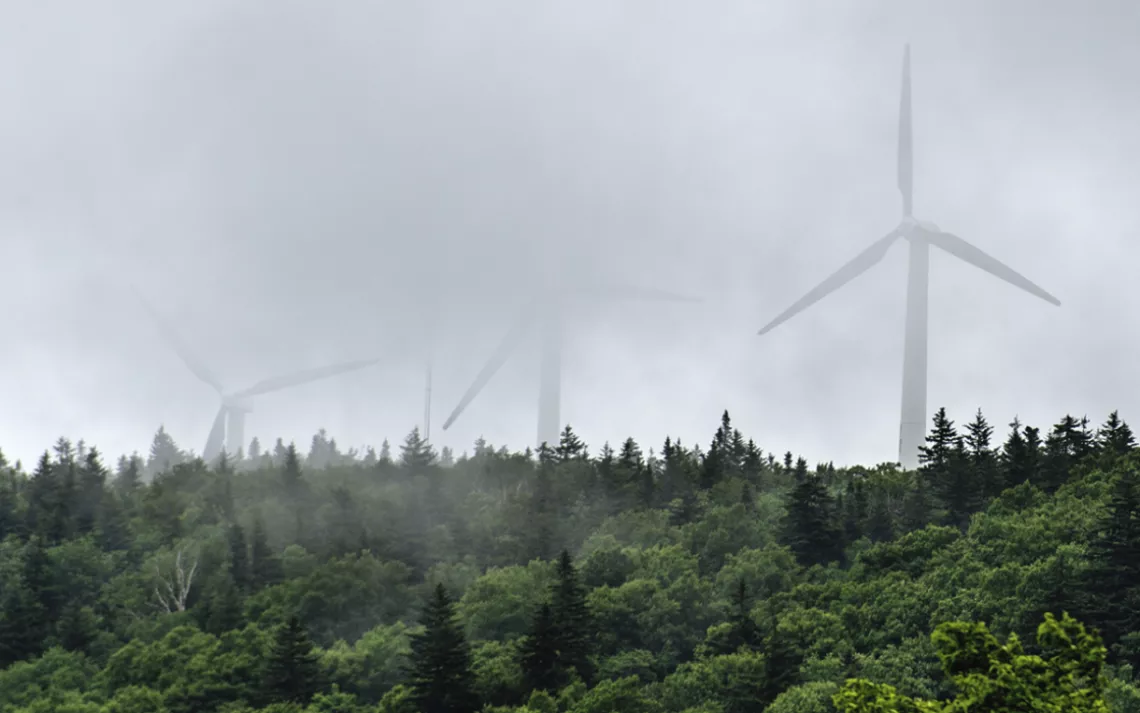
The Searsburg Wind Energy Facility
THE WIND IS TOO FIERCE to hike any farther up the wooded ridge to the 15 wind turbines that make up the Deerfield Wind Farm. That, after all, is why they're here. Fifteen years in the planning, the 30-megawatt Deerfield now produces enough energy to power 14,000 Vermont households in the nearby towns of Searsburg and Readsboro, which also share $6.8 million in direct payments from the project. "Those are wicked gusts," observes my guide, Justin Lindholm, who in his black-and-green plaid jacket and rubber boots looks to be every inch what he actually is, a native Vermonter.
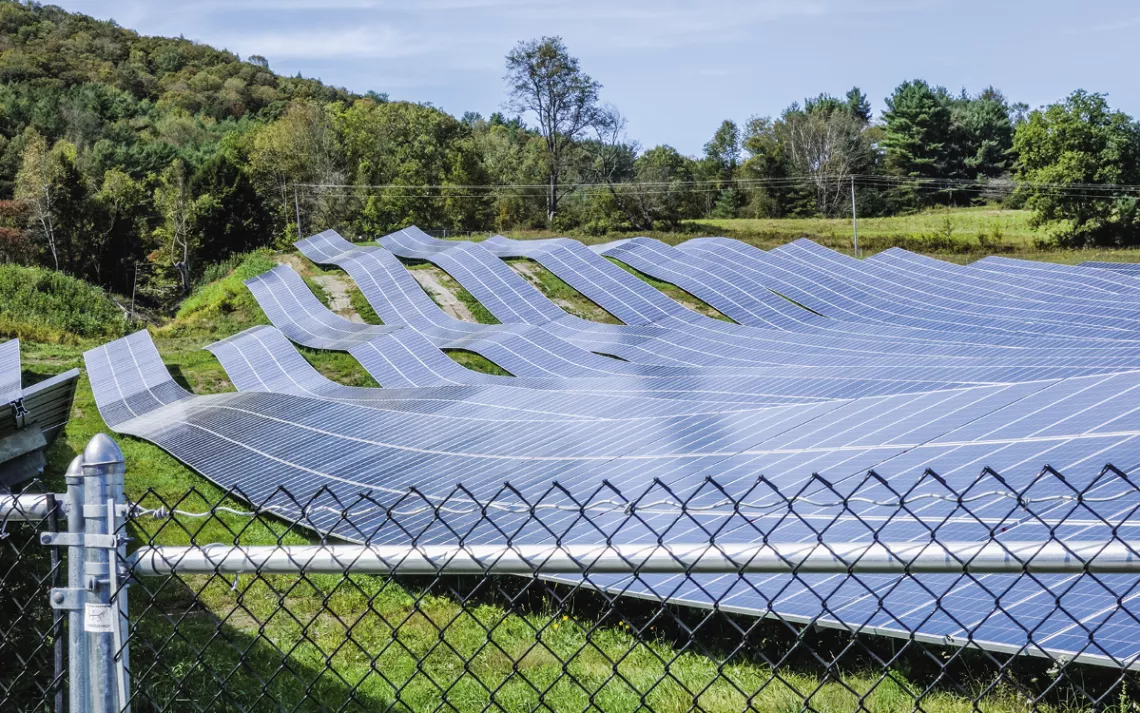
Solar installations like this community array in South Royalton provide about 10 percent of Vermont's electricity.
This would strike many as an iconic scene in the crunchier-than-thou home state of Senator Bernie Sanders, environmental author and activist Bill McKibben, and the ice cream company Ben & Jerry's. With its rolling hills, organic farms, roadside maple syrup stands, and white clapboard churches on quaint town squares, Vermont looks as picture-perfect as its renewable energy portfolio: Of the electricity generated in-state, 99.9 percent is from renewable sources, "a larger share than in any other state," according to the US Energy Information Administration. Most is from hydropower, about 20 percent from biomass, and 18 percent from Vermont's five wind farms—a larger share than in 80 percent of the other states.
Yet to Lindholm, a dedicated, lifetime outdoorsman with a deep love for his state, the slowly spinning turbines are an abomination. "I am totally against ridgeline wind," he says. "It destroys some of the most fragile features of these mountains. They blast to build roads and bring the blades up—a million pounds of explosives in some cases. 'Wind' is a four-letter word in Vermont." Lindholm also hates the noise generated by turbines, claiming that it keeps residents up at night. "Some have had to be bought out," he says. "They're keeping the agreements quiet." On this blustery day, you can't hear much of anything from the turbines. Maybe the wind is blowing in the wrong direction.
Lindholm isn't much happier with the 20-megawatt solar farm—Vermont's largest—in Ludlow, 50 miles to the north. It's not what you'd call imposing, with rows of panels on a gentle hillside across the road from an aging farm displaying rusty agricultural implements and a big Trump sign. But Lindholm complains that 60 of its 100 acres were once farmland. "We have such rocky soil, prime agricultural land is rare," he says.
Ask Lindholm how we can save the planet without utility-scale renewables and he'll give you a fatalistic, Malthusian answer: We won't. "I figured out years ago that human population growth is unstoppable," he says.
No polling data is available on how many other Vermonters have given up on humanity, but there are enough to stymie any major new renewable energy projects in the state. In 2012, Vermont had at least a dozen wind projects in development. Today, there are none. No industrial-scale wind or solar projects are underway anywhere in the state. "I love Vermont dearly and admire its conservation ethic," Bill McKibben told Sierra. "But there are moments, faced with a global crisis, when it feels like the state motto should be 'Don't change a thing until I die.' I very much look forward to the day when there's a big wind turbine up on top of Middlebury Gap above my home."
VERMONT LIVES UP TO ITS image in many ways. There actually are crusty but lovable natives who speak their piece at town meetings. The state has embraced small-scale solar, and unobtrusive installations dot the roadsides. All told, Vermont produces 245 megawatts from the sun, which accounted for 11 percent of its electricity in 2018. But while Vermont has been called the nation's greenest state, that reputation may no longer be deserved. Since the 604-megawatt Vermont Yankee nuclear plant shut down in 2014, the state has generated only two-fifths of the electricity it uses. The rest is imported from other states and Canada, with gas and hydro (plus New Hampshire nuclear) in the mix. Says James Moore, co-president of SunCommon, the state's largest solar installer, "We've exported a lot of our environmental impact."
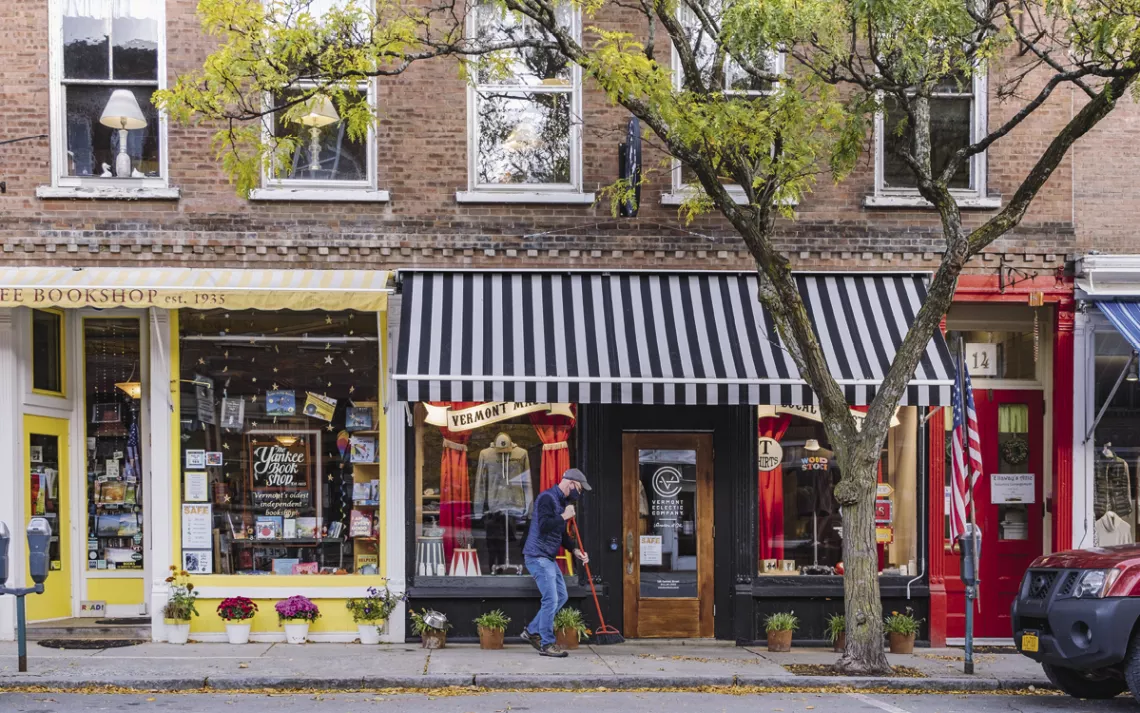
Vermonters' small-town ethos goes hand in hand with resistance to renewable energy development.
Some opposition to renewable energy projects is based on legitimate concerns about protecting natural spaces. But a good portion of the resistance is due to NIMBYism—the "not in my backyard" syndrome. Both anti-development gadflies and wealthy communities with big bankrolls have become adept at stopping needed projects. In Vermont—as elsewhere in the nation—you can't underestimate the power of people not wanting to look at something and having the means to make the problem go away.
"It's people with good intentions not wanting to see change in their little piece of the world," Moore says. "We might dress it up in flannel in Vermont, but NIMBYism is NIMBYism. I think we are dangerously close to letting the perfect be the enemy of a livable planet."
The headquarters of Vermont's opposition to utility-scale renewable power is Annette Smith's rustic, off-the-grid farm in rural Danby. Smith is the founder and director of Vermonters for a Clean Environment, the group she uses as a cudgel against clean energy developers, and not just the large ones—she is just as likely to organize state residents to fight one- or two-turbine installations in the remote counties of the isolated Northeast Kingdom.
"Wind is not a happy scene in Vermont," says Smith, after guiding a tour of her property, which includes three cows, a lone goose, and solar panels. "It's the same in every community," she says, sitting in a chair she made herself. "The developers go where land is cheap and people are poor. Searsburg is an example of that. We've seen so much done wrong here, and that's why there's a backlash against renewable energy. It's turned Democrats into Republicans."
Smith is not a political ideologue. She grew up in Sarasota, Florida, played the violin, and graduated from Vassar with a degree in history. She built harpsichords with her husband, Bill, and once, she posed nude for a painting on the lid of one (a depiction of Leda and the Swan). Her transition to activist was gradual, starting with a fight against a fracked-gas pipeline and two gas-fired power plants. But what she thought would be a brief interruption in a determinedly out-of-the-mainstream life became a highly successful personal crusade.
"My motivation was the scale and inappropriateness of a certain kind of development, rather than [opposition to] renewable energy," she says. "Do I take credit for stopping the pipeline and those plants? Definitely, yes. The Bennington Banner called me a 'one-woman wrecking crew.'"
What about offshore wind projects—with no noise issues or close neighbors? Smith admits to some ambivalence ("I don't know what to make of it") but suggests objections: poor durability in salt air and weather, underwater transmission lines, threats to whales.
"How much of the planet are we prepared to sacrifice to meet humanity's need for energy?" she asks. "Why can't we meet our needs without digging, drilling, undergrounding, and building yet more technology that requires massive impacts on the earth?" She says she likes renewable energy when it's small in scale, like the solar panels in her backyard, and she walks her talk. "Every save-the-planet environmentalist you interviewed has a heavier carbon footprint than Annette Smith," says Lindholm, who embraces the same lifestyle; he hasn't been on a jet airplane in this century.
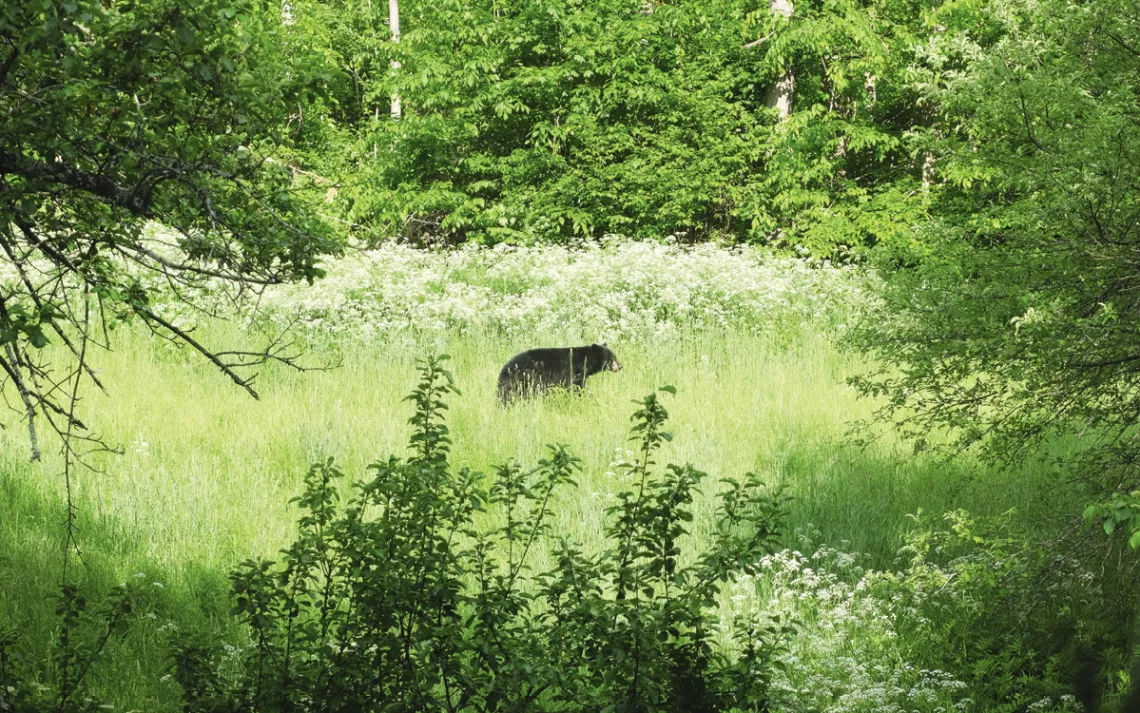
Critics complain that solar installations take too much land away from wildlife and agriculture.
That Whole Earth Catalog ethos may be the secret to Smith and Lindholm's successful brand of NIMBYism: For famously self-reliant Vermonters, it reframes energy from a societal problem to an individual choice. If everyone lived a simple, back-to-the-land lifestyle, there would be no need for giant wind turbines.
Olivia Campbell Andersen, executive director of Renewable Energy Vermont, isn't buying it. "In Vermont, wind power is the most renewable, cost-effective, and affordable energy available," she says. "It saves ratepayers money and has enabled many towns to have better schools and firehouses." She sees "a lot of hypocrisy" in those who oppose renewable energy projects but don't object to using energy generated from coal. In response to Smith's contention that it's poor Vermonters who are victimized, Andersen argues that those who are most united in opposition are "wealthier people who may have second homes."
Attempting to span this gulf are Vermont's progressive icons, who strongly support renewable energy but are reluctant to label its opponents. Since 2019, for instance, Ben & Jerry's has partnered with the Sierra Club's Ready for 100 campaign "to advance the goal of powering the US with 100 percent clean and renewable energy." The company (now owned by Unilever) campaigns mostly on the national level, but its foundation gave $16,000 to the McKibben-linked 350Vermont in 2020, and the company itself pledges to use 100 percent renewable energy in its operations by 2025.
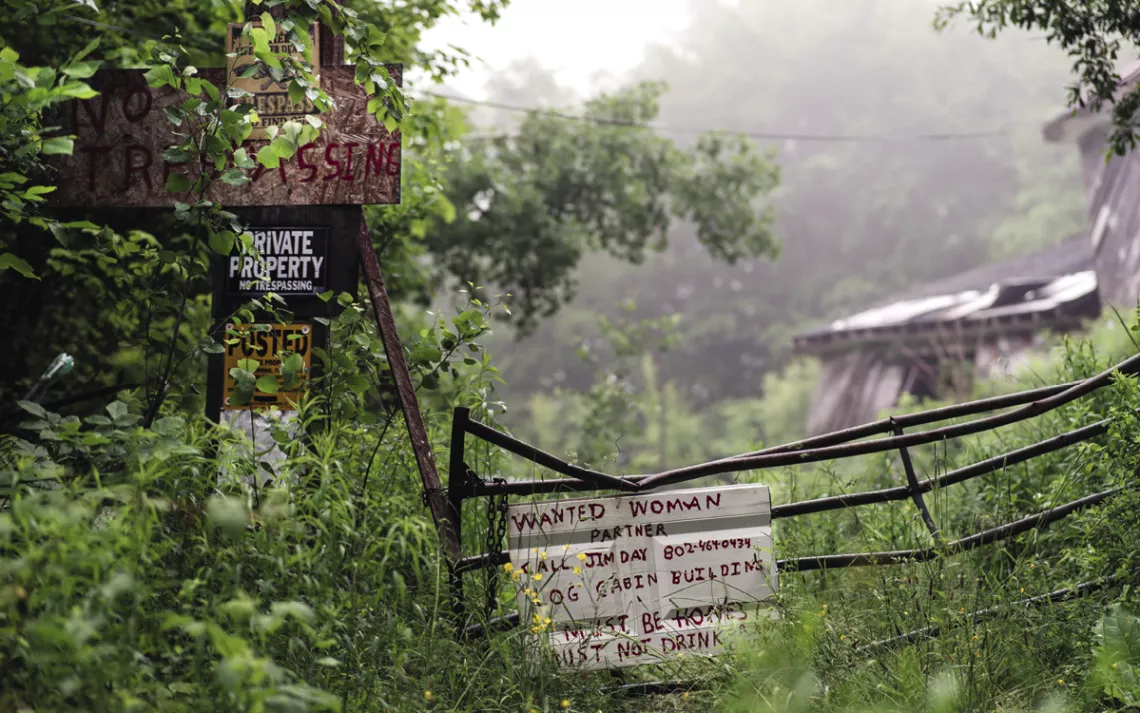
Annette Smith says developers "go where land is cheap and people are poor," like rural Searsburg.
"I don't think of what's happening in Vermont as NIMBYism," says Jerry Greenfield (the Jerry to Ben). "I see it as people with honest, genuine concerns, and I respect that. But we need to look at the big picture and see where our energy is coming from. The alternatives are way worse." Vermont, he says, "is seen as this environmentally forward place, with beautiful, rolling green fields and streams. But in terms of what the state is actually doing, it's just not stepping up."
The big green dog in the state is, of course, Bernie Sanders, a major supporter of the Green New Deal. In a statement from his office, Sanders said that an energy transition to renewables is essential to protecting "iconic Vermont pastimes like maple sugaring, skiing, and snowmobiling" from climate change. "Senator Sanders is proud that, in many ways, Vermont has been a leader in this transition," the statement said. "The state legislature created the first statewide energy-efficiency utility in the country in 1999, and the senator's hometown of Burlington became the first city in the nation to get 100 percent of its electricity from renewables in 2014. However, we cannot allow Vermont's notable successes to make us complacent; we still have a lot of work to do, especially in the buildings and transportation sectors. We must act boldly at all levels of government."
BOLD ACTION IS NOT WHAT'S HAPPENING in the Green Mountain State. Vermont's wind resources are relatively modest; the National Renewable Energy Laboratory says that Vermont has just three potential gigawatts of developable wind. That's enough to make a state with such a tiny population self-sustaining on energy. But most of that wind is on Vermont's scenic ridgelines. After the construction of five wind farms between 1997 and 2017, a public backlash encouraged by Smith halted further development.
Chad Farrell is the founder and CEO of Encore Renewable Energy, one of Vermont's major renewable developers. He's now looking to expand his company elsewhere. "Every project in this state is some kind of trip hazard," he says, "and a lot of times NIMBYism is behind it. It's something we have struggled with and worked hard to overcome."
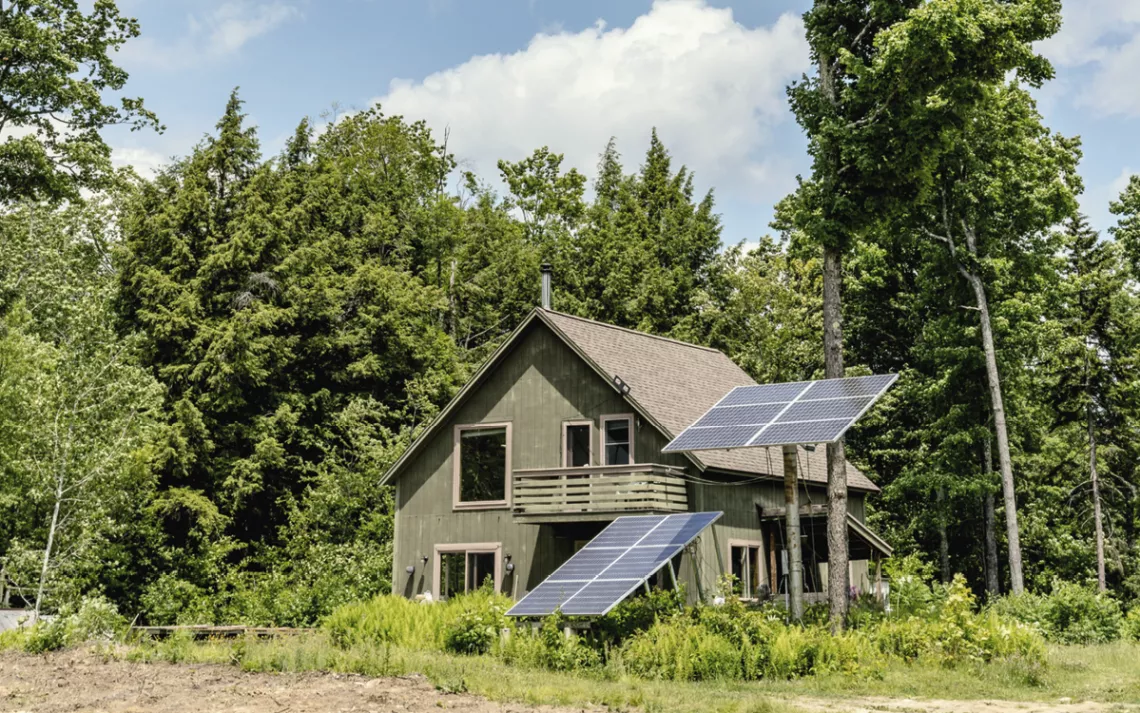
Many Vermonters' ideal is off-the-grid, private systems like at this homestead in Barnard.
Farrell came up against Smith a decade ago over a pair of 2.2-megawatt turbines on a farm in the town of Derby Line, near the Canadian border. "It was a vulnerable time for our business," he says. "We had to pack up our tents, because we couldn't afford millions of dollars and 10 years of fighting over two turbines. The farmer worked hard to build support, but in the end we had to tell him that we were sorry."
Farrell frames his effort as self-reliance too, but for the entire state, not just individuals. "The ability to control our energy future independently within state boundaries should be something to be celebrated, not fought against," he says. "We're going to deliver as many megawatts of renewable energy in Maine over the next year and a half as we did in Vermont over 10 years," he adds.
The amount of renewable energy at play in Vermont may be trivial, but NIMBY opposition is everywhere and could pose big obstacles for President Joe Biden's ambitious energy and climate change plans. Biden has set a goal of a carbon-free power sector by 2035, followed by a net-zero economy by 2050. The Green New Deal embraces that same 2050 goal, envisioning "meeting 100 percent of the power demand in the United States through clean, renewable, and zero-emission energy sources."
Achieving those climate goals involves a big commitment to big renewable energy projects. That entails a willingness to site them—even in spitting distance of someone's backyard. Mark Jacobson, director of Stanford University's Atmosphere/Energy Program, has attempted to quantify how many renewable energy installations the United States will actually need. He reckons 223,000 five-megawatt onshore wind turbines, 171,000 five-megawatt offshore turbines, 44,000 50-megawatt utility-scale photovoltaic (PV) systems, 77 100-megawatt geothermal plants, 137 million five-kilowatt residential rooftop PV systems, 8.7 million 100-kilowatt commercial and government rooftop PV systems, and 19 100-megawatt concentrated solar power plants.
All those turbines and solar panels (plus the requisite transmission lines) have to go somewhere. But many communities—including those full of avowed liberals and environmentalists—are working hard to make sure they go somewhere else. In Klickitat County, Washington, retirees who moved to the area for its scenic views convinced their board of commissioners to stop permitting solar farms. In 2019, California's San Bernardino County prohibited the construction of big wind and solar farms on more than a million acres of private land. The Los Angeles Times said that the ruling was "bending to the will of residents who say they don't want renewable energy projects industrializing their rural desert communities." In Coxsackie, New York, a group called Citizens for Sensible Solar organized to stop the construction of utility-scale solar plants that would "destroy the rural aesthetic of their homes.” In Culpeper, Virginia, the blocking of an 80-megawatt solar farm led to the creation of the nonprofit Citizens for Responsible Solar, which works to stop utility-scale projects nationwide. "Rural communities are under attack from big, corporate solar developers (some foreign) who want to build large-scale, industrial solar power plants on agricultural- and forestry-zoned land to take advantage of lower development costs," the group says.
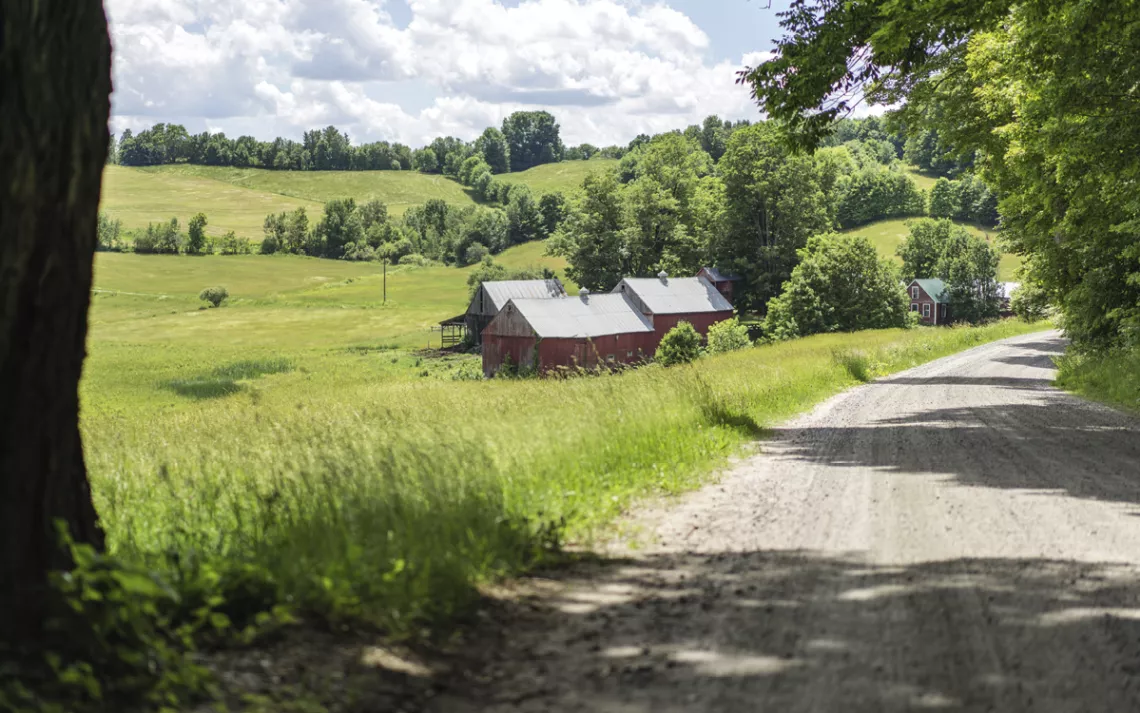
Vermonters are intent on preserving the state's rural character, which is why there are no industrial-scale solar or wind projects under construction anywhere in Vermont.
In terms of organizing heft, no rural mom-and-pop NIMBY group can rival the Alliance to Protect Nantucket Sound, which waged a 16-year battle to kill the Cape Wind Project, a 130-turbine, 454-megawatt offshore wind farm that would have provided 75 percent of the energy for Cape Cod, Martha's Vineyard, and Nantucket. The powerhouse group spanned the ideological spectrum, with support from both the Kennedy family and billionaire William Koch, and was known for burying opponents in blizzards of filings and technical arguments. The late Ted Kennedy, then a Democratic senator from Massachusetts, expressed his objection simply: "Don't you realize—it's where I sail." Koch, who donated $5 million to the cause, is a big sailor too (he won the America's Cup in 1992), but he's also in the fossil fuel business, and he's motivated by protecting his extensive real estate holdings against "visual pollution." He told The New York Times, "The ability to acquire a special property where I can create a family compound for my children and extended family was and is very meaningful to me."
The would-be developers of Cape Wind surrendered their federal lease in 2017 after a series of setbacks orchestrated in part by the Alliance to Protect Nantucket Sound. "We must remain vigilant to ensure long-term protection for the Sound so that it is never again threatened by industrial development," says the group on its website.
MORE RECENTLY, Citizens for the Preservation of Wainscott is hoping to repeat the alliance's success in rallying the 1 percent. Wainscott is a hamlet in East Hampton, Long Island, a seaside escape for wealthy New Yorkers where the median home price is $1.8 million. Denmark's Ørsted A/S and Eversource Energy, New England's largest energy provider, want to build a 12-turbine wind farm 35 miles offshore that would produce an estimated 130 megawatts and be operational by late 2023.
If Citizens for the Preservation of Wainscott has its way, the farm will never be built. The group insists it's not against wind power per se. Instead, its focus is on a single transmission cable that would come ashore on exclusive Beach Lane, then run to the Cove Hollow Road substation in East Hampton to be connected to the wider electric grid. The group claims to have "serious concerns" about water pollution, access for emergency vehicles, and "an unnecessary new substation."
Residents who signed a 2018 petition against the cable included billionaire Ronald Lauder, actress Edie Falco, futurist Faith Popcorn, and Daniel Neidich, a former business partner of Steven Mnuchin in Dune Capital Management and also a Citizens director. In written replies to questions, Citizens derided "New York State's rush to achieve its clean energy goals." The group says it supports wind energy, but "there are better alternatives to using miles of residential streets to snake the cable to a substation."
Despite the opposition, New York State's Public Service Commission approved the transmission cable route last March. It's still coming ashore in Wainscott and will be buried 30 feet underground. Citizens for the Preservation of Wainscott hasn't given up the fight, though. It asked the PSC to reconsider, sued East Hampton, and is "poised" for further litigation.
"Some of these people have big bucks, and they aren't used to losing," Jerry Mulligan, a retired lawyer in East Hampton who favors the wind farm, told The Guardian. In a letter to the East Hampton Star, he called Citizens "just a small, moneyed NIMBY group who want electricity for Wainscott without any involvement or inconvenience on their part." Mulligan says he still plays tennis with opponents—they just try not to talk about the wind.
THE WORLD INVESTED HALF A TRILLION DOLLARS in decarbonization in 2020, reports BloombergNEF, which says that more than half the world's electricity will be produced by wind and solar by 2050. The long-term prospects are very good—the price of offshore wind turbines has fallen by 80 percent in the past 20 years, and solar installations are growing rapidly and becoming more affordable. Yet solar accounted for only 2.3 percent of US generation in 2020. And though as many as 16 offshore wind farms have been proposed on the East Coast, the United States has a total of seven offshore wind turbines. Europe has 5,400.
In May 2021, the Biden administration approved what will be the country's first commercial-scale offshore wind project in the waters off Martha's Vineyard. With up to 84 turbines and 800 megawatts, Vineyard Wind will generate enough power for 400,000 homes. Commercial fishers aren't happy—their Responsible Offshore Development Alliance condemns the approval as "scattershot, partisan, and opaque." But at least so far, there are no legions of lawyers to rival those arrayed against Cape Wind. It helps that wind technology is advancing, enabling larger farms farther out at sea—and out of sight.
Audra Parker, executive director of the Alliance to Protect Nantucket Sound, is surprisingly sanguine about Vineyard Wind and hasn't spoken out against it. "Our position hasn't changed," she says. "We support renewable energy, assuming it's responsibly sited, cost-effective, and has the support of the local community. Cape Wind had none of those. Involving the community early on is extremely important."
Steve Crowley, climate and energy chair of the Sierra Club's Vermont Chapter, says that the chapter has taken positions both for and against wind sitings. It opposed Deerfield Wind because it's close to the George D. Aiken Wilderness and was against a later expansion because of its impacts on critical bear habitat. But the chapter supported a (never built) wind project on Equinox Mountain in Manchester and a wind study on East Mountain.
Crowley credits Smith's community engagement with changing a lot of minds. "Her group gets in at the first hint of a project and starts spreading not-always-accurate information about the impacts," he says. "They're scaring people before they have a chance to listen objectively."
Robb Kidd, who runs the chapter's priority campaigns, tells about a eureka moment he had regarding renewable energy siting. He was talking to Søren Hermansen, the renewable energy evangelist from the Danish island of Samsø, which generates all its own power from wind and biomass (and sells excess to the mainland). Kidd asked Hermansen how Samsø got locals on board. "He said before the construction started, they worked in the community to assess the needs," Kidd says. "The developers here didn't do that very well. They should get in the habit of working closely with communities."
And what should be their message to those communities? They could emphasize that a rapidly changing climate and the urgent need to slow that change leave us with a shrinking pool of options. They could make it clear that massive change is coming, the severity and scope of which will be determined by how we choose to respond now—as individuals trying to preserve comfortable lives and lovely sight lines for the rest of our days or as communities trying to maintain a livable planet for our grandchildren. There will be painful trade-offs; that much is assured. Our task is to agree, together, on which ones we can live with.
This article appeared in the Fall quarterly edition with the headline "Vermont Values."
This article was funded by the Sierra Club's Beyond Coal Campaign.
This article has been corrected.
 The Magazine of The Sierra Club
The Magazine of The Sierra Club



